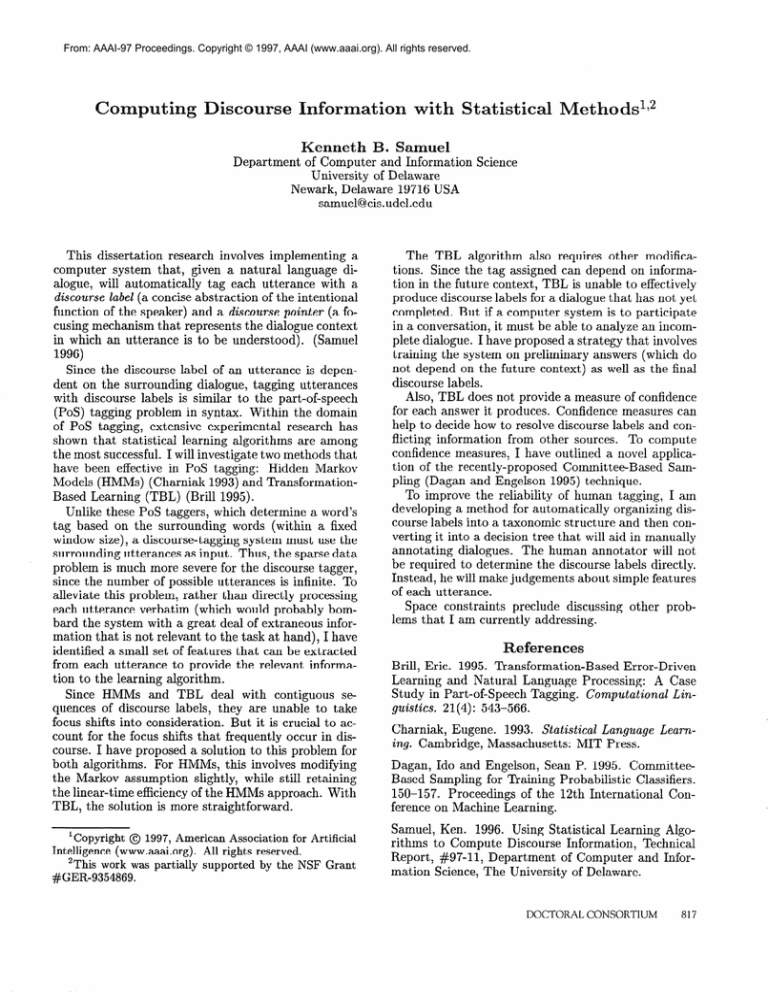
From: AAAI-97 Proceedings. Copyright © 1997, AAAI (www.aaai.org). All rights reserved.
Computing
Discourse
Information
Kenneth
with Statistical
Methods1~2
EL Samuel
Department of Computer and Information Science
University of Delaware
Newark, Delaware 19716 USA
samuel@cis.udel.edu
This dissertation research involves implementing a
computer system that, given a natural language dialogue, will automatically tag each utterance with a
discourse label (a concise abstraction of the intentional
function of the speaker) and a discourse pointer (a focusing mechanism that represents the dialogue context
in which an utterance is to be understood). (Samuel
1996)
Since the discourse label of an utterance is dependent on the surrounding dialogue, tagging utterances
with discourse labels is similar to the part-of-speech
(PoS) tagging problem in syntax. Within the domain
of PoS tagging, extensive experimental research has
shown that statistical learning algorithms are among
the most successful. I will investigate two methods that
have been effective in PoS tagging: Hidden Markov
Models (HMMs) (Ch arniak 1993) and TransformationBased Learning (TBL) (Brill 1995).
Unlike these PoS taggers, which determine a word’s
tag based on the surrounding words (within a fixed
window size), a discourse-tagging system must use the
surrounding utterances as input. Thus, the sparse data
problem is much more severe for the discourse tagger,
since the number of possible utterances is infinite. To
alleviate this problem, rather than directly processing
each utterance verbatim (which would probably bombard the system with a great deal of extraneous information that is not relevant to the task at hand), I have
identified a small set of features that can be extracted
from each utterance to provide the relevant information to the learning algorithm.
Since HMMs and TBL deal with contiguous sequences of discourse labels, they are unable to take
focus shifts into consideration. But it is crucial to account for the focus shifts that frequently occur in discourse. I have proposed a solution to this problem for
both algorithms. For HMMs, this involves modifying
the Markov assumption slightly, while still retaining
the linear-time efficiency of the HMMs approach. With
TBL, the solution is more straightforward.
‘Copyright @ 1997, American Association for Artificial
Intelligence (www.aaai.org). All rights reserved.
2This work was partially supported by the NSF Grant
#GER-9354869.
The TBL algorithm also requires other modifications. Since the tag assigned can depend on information in the future context, TBL is unable to effectively
produce discourse labels for a dialogue that has not yet
completed. But if a computer system is to participate
in a conversation, it must be able to analyze an incomplete dialogue. I have proposed a strategy that involves
training the system on preliminary answers (which do
not depend on the future context) as well as the final
discourse labels.
Also, TBL does not provide a measure of confidence
for each answer it produces. Confidence measures can
help to decide how to resolve discourse labels and conflicting information from other sources. To compute
confidence measures, I have outlined a novel application of the recently-proposed Committee-Based Sampling (Dagan and Engelson 1995) technique.
To improve the reliability of human tagging, I am
developing a method for automatically organizing discourse labels into a taxonomic structure and then converting it into a decision tree that will aid in manually
annotating dialogues. The human annotator will not
be required to determine the discourse labels directly.
Instead, he will make judgements about simple features
of each utterance.
Space constraints preclude discussing other problems that I am currently addressing.
eferences
Brill, Eric. 1995. Transformation-Based Error-Driven
Learning and Natural Language Processing: A Case
Study in Part-of-Speech Tagging. Computational Linguistics. 21(4): 543-566.
Charniak, Eugene. 1993. Statistical Language Learning. Cambridge, Massachusetts: MIT Press.
_^-_
Dagan, Id0 and Engeison, Sean P. lYY5. CommitteeBased Sampling for Training Probabilistic Classifiers.
150-157. Proceedings of the 12th International Conference on Machine Learning.
Samuel, Ken. 1996. Using Statistical Learning Algorithms to Compute Discourse Information, Technical
Report, #97-11, Department of Computer and Information Science, The University of Delaware.
DOCTORAL CONSORTIUM
817








